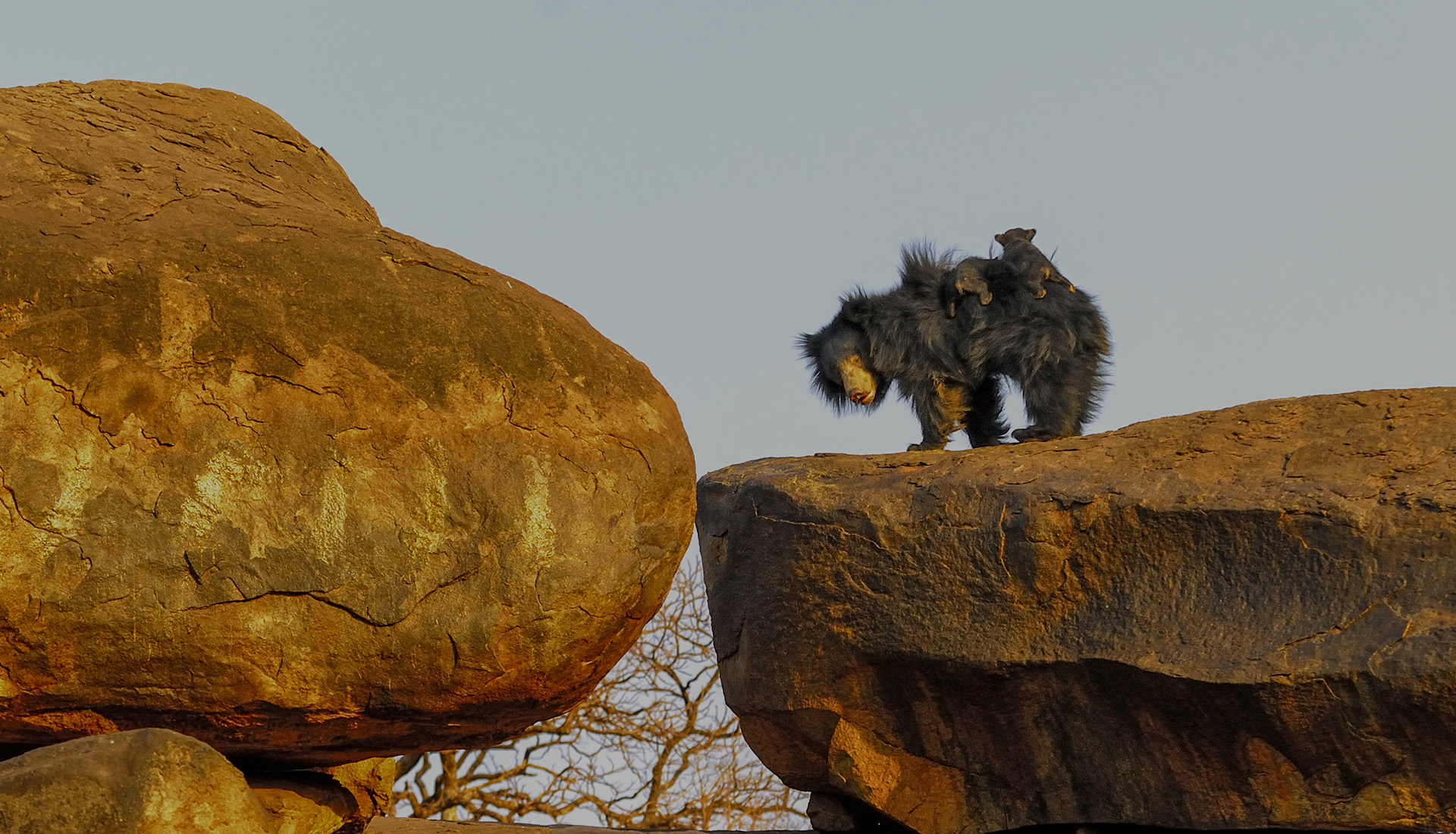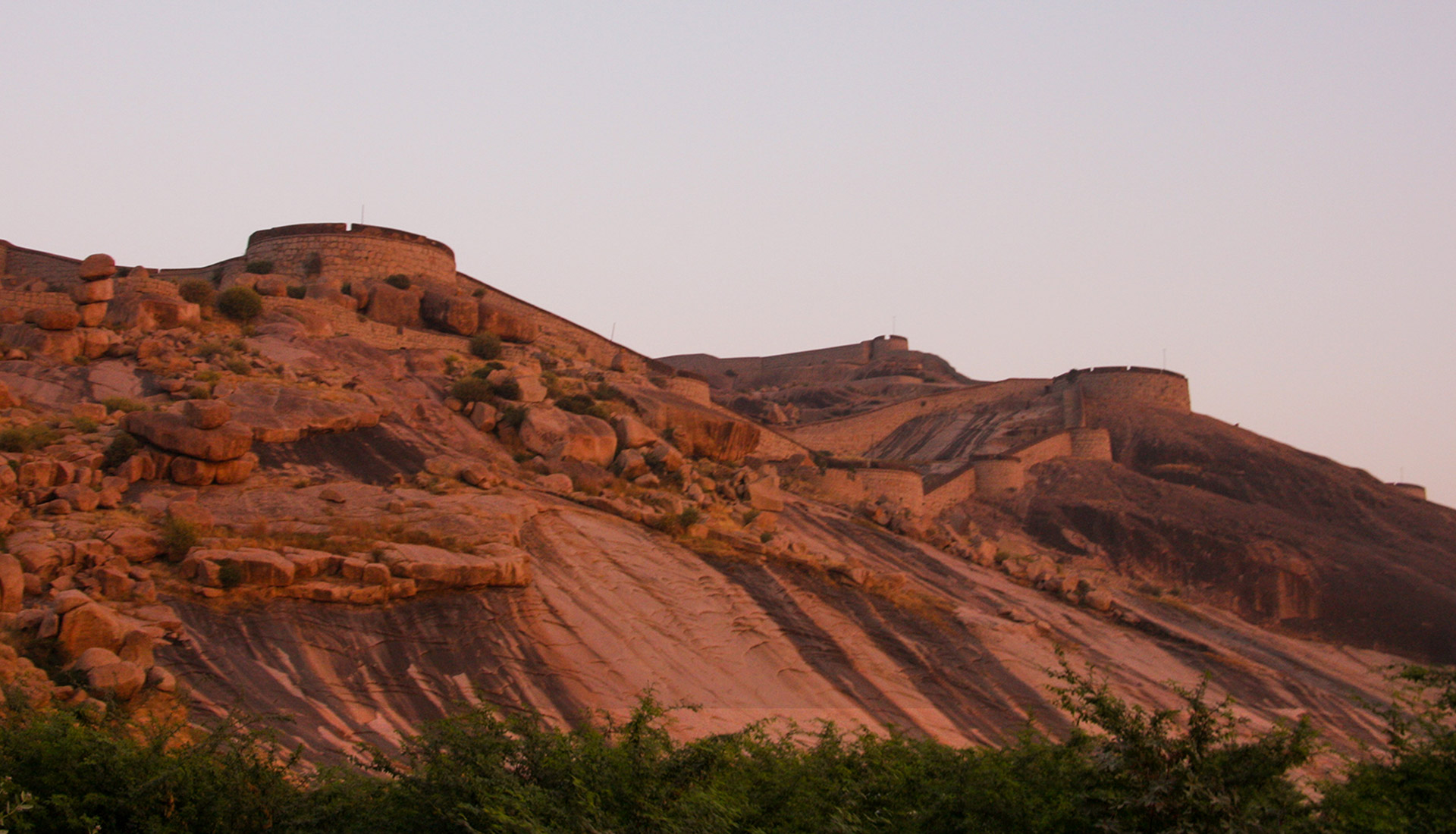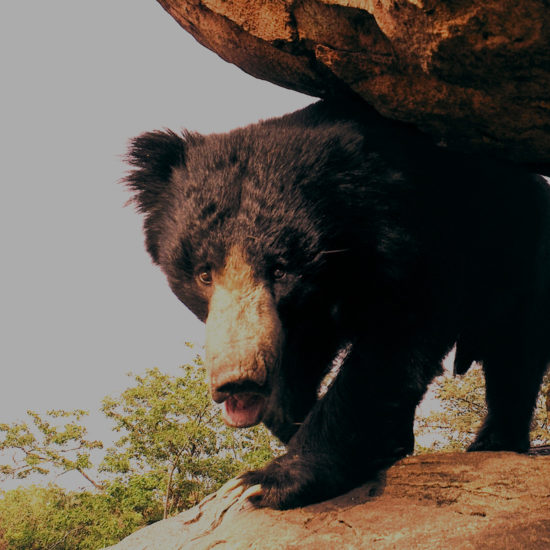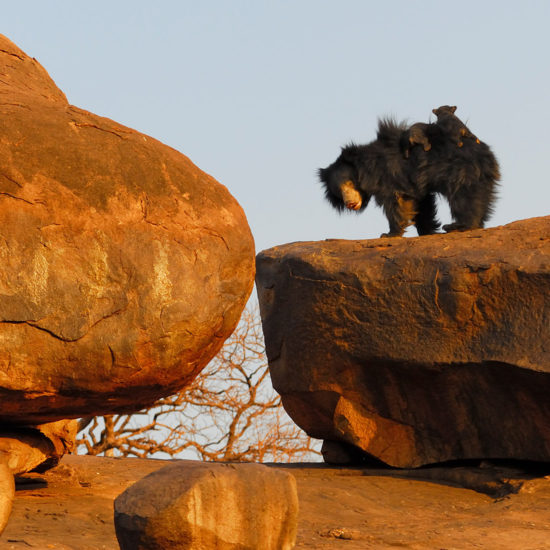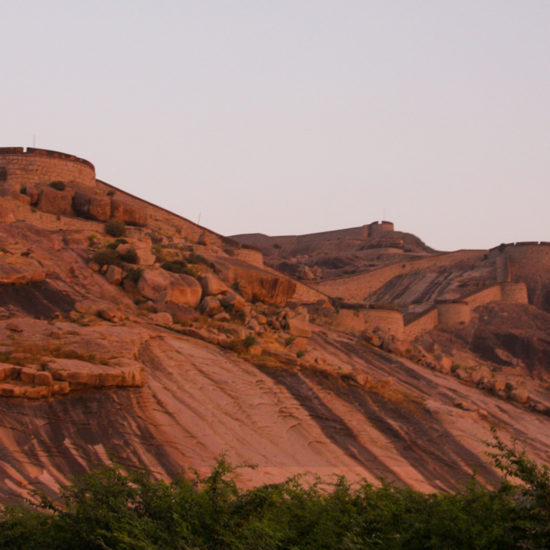Ballari is situated on the eastern side of Karnataka and is surrounded by Raichur and Koppal on the north, Haveri and Gadag on the west, Chitradurga and Davanagere on the south, and Anantapur and Kurnool (Andhra Pradesh) on the east. Ballari has been a meeting place for people from Karnataka and Andhra Pradesh hence offering a tradition and culture mix of both the states.
Ballari has a very diverse and rich past. Mythologically, Ballari was closely associated with the epic Ramayana with the mythical kingdom of Kishkinda, the famed monkey kingdom which was inhabited by Vanaras (monkeys). Anjaneya Hill, located across the river Tungabhadra, is believed to be the birthplace of Lord Hanuman. There are many more incidents of Ramayana associated with this place. Another legend associated with is Goddess Pampadevi, who is believed to have done penance on the bank of the River Pampa (Tungabhadra) and as the result of which she was able to marry Lord Shiva, who was also called Virupaksha to whom the celebrated ancient temple in Hampi is dedicated. The marriage of Lord Shiva and Goddess Pampadevi is still recreated annually here. In terms of archaeology, Ballari is one of those regions where the existence of man has been found with excavations here dating to the Neolithic period in places like Ballari, Sanganakallu-Kupgal, etc. But perhaps, the most important chapter in Ballari’s history has been the Vijayanagara Empire with the UNESCO World Heritage site Hampi. Vijayanagara Empire at its peak was very prosperous and was believed to be larger than Rome with palaces grander than Lisbon. There were opulent palaces, marvelous temples, massive fortifications, baths, markets, aqua-ducts, pavilions, stables for royal elephants, and elegantly carved pillars. This was a city whose merchants traded in diamonds, pearls, horses, fine silks, and brocades. Today, Ballari is popular for cotton, one of their major crops, and the city is known to have a thriving cotton industry. This district is endowed with rich mineral resources especially iron ore and hence is aptly called “The Iron City”.
For further information, visit the official district websiteclick here!
Fast Facts
When to go: The monsoon (July-September) and winter (November-February).
Catch the 3-day Hampi Fest in November. In Jan-Feb check out the legendary Virupaksha Temple Car Festival and the annual Purandaradasa Aradhana Music Festival at Vithala.
Temple
Tourist Office:
Office Of The Deputy Director
Department of Tourism
Near Lotus Mahal, Kamalapura, Hospet
Cell: +91-9880-404150″
Heritage Sites
-
- Bellary Fort: Situated in the historic city of Ballari, the Ballari Fort is built on top of Ballari Gudda or Fort Hill. The fort is believed to have been built during Vijayanagara times by the Palegar chief Hanumappa Nayaka. Hyder Ali took possession of the fort from the Nayakas in 1769 and got it renovated and modified with the help of a French engineer. Legend has it that the engineer was hanged, for overlooking the fact that the neighbouring Kumbara Gudda was taller than Ballari Gudda, thus compromising the secrecy and command of the fort. His grave is believed to be located near the East Gate of the fort, though some locals believe it to be the grave of a Muslim holy man. Visit the illuminated fort in the evenings and watch the past come alive.
- Sanganakallu: The Sanganakallu-Kupgal area is an ancient archaeological site and the excavations here have been dated to the Neolithic period, between 5,000 and 10,000 years ago. The Sanganakallu-Kupgal area is the location of one of the oldest village settlements discovered in Asia. The excavations are cantered around four hills that have shown evidence of inhabitation during the Neolithic period. Archaeologists have discovered that the area was a large center for the production of stone tools and implements as well as etched stone seals and inscriptions. The area also offers the opportunity to view rock art, ancient burial mounds, and unique ringing stones.
- Siruguppa: The name Siruguppa means "pile/ heap of wealth". On a fort here, stands an old temple dedicated to Lord Shambhulinga which is believed to be the oldest temple here.
Religious Places
- Bommaghatta (T. Sandur) is a small interior that has an old temple of Hulikuntiraya (Anjaneyaswamy) which draws devotees not only from the Ballari district but also from the neighbouring districts.
- Chellagurki (T. Ballari) is a village l6 km from Ballari on Ballari-Anantapur road, which has become well-known on account of the Jiva Samadhi of Yerri Tata. This great saint came to Chellagurki in the year 1897 and lived here till his death in 1922. He is credited with having performed several miracles. Pilgrims from all over the State visit the Samadhi of Yerri Tata, especially on new moon days and on the occasion of the annual car festival held in his honor. Facilities for lodging and boarding have been provided for the pilgrims.
- Dammur (T. Ballari): is about 17 km from Dammur Ballari city. It is well known for its cave temple and the Samadhi (tomb) of Venkappa. An annual fair is held here.
- Hulikuntiraya Temple, Bommaghatta: Bommaghatta is home to an old temple of Hulikuntiraya (Lord Hanuman) which is quite popular with devotees from Ballari and neighboring districts.
- Kotturu: Kotturu is a town in Ballary district popular for Samadhi (final resting place) of Basappa Lingaswamy (also known as Kotra Basappa or Kotturaswamy). The Samadhi is a huge stone structure with multiple painted stone images. Kotrabasappa Temple, built-in memory of the saint, is an important landmark in Kotturu. Kottur is 102 km from Ballari.
- Kurugodu: Home to a cluster of nine temples dating back to the 12th century AD. Sangameshwara temple, Siddeshwara Temple, Mallikarjuna Temple, and Ujjaleshwara Temple are major ones.
- Mailara: Mailara, also known as Mannetti Mailara is a center of worship in the Ballari district. Mailara Lingeshwara Temple is built in Mailara in honour of Lord Shiva. Kumaraswamy Temple and Parvati Temple, Sandur: Sandur is notable for two ancient Hindu temples which are located in the same compound, and are both protected monuments. The famous of the two is the Kumaraswamy Temple (11-12 century), believed to be the first abode in South India of Lord Kumaraswami (Karthikeya) which is picturesquely situated on the wooded slopes at the head of a ravine. The image of the deity is made of black stone that is holding a club in his hand and beside him stands his vehicle, the peacock. To art historians, the Parvati Temple located nearby (7th-8th century) is more unusual in terms of Hindu temple architecture. There are fine figures of divinities in the temple and many well-executed images placed on pedestals in the interior of this temple.
- Tambrahalli: Home to Ranganatha Temple and a stepwell.
Wildlife
- Daroji Sloth Bear Sanctuary: Daroji Sloth Bear Sanctuary is the first Sloth Bear Sanctuary in India and Asia, declared exclusively for the protection and conservation of the Sloth Bear. Daroji Bear Sanctuary is spread over 82.7 square km Sightings from machans are normally organized in the evenings as these bears are mostly nocturnal. Home to a large number of free-ranging bears; the sanctuary also has hyenas, wild boars, pangolins, porcupines, jackals, and leopards. Other denizens include star tortoise, monitor lizard, and rock agama. A drive through the scrub jungle also provides opportunities to sight endemic species of birds such as the painted spurfowl, yellow-throated bulbul, sand grouse, stone curlew, and peafowl. Located at the edge of the Daroji Sloth Bear Sanctuary is a property of Jungle Lodges & Resorts which provides accmmodation facilities and safari rides.
- Gudekote Sloth Bear Sanctuary:Gudekote Sloth Bear Sanctuary is the second Sloth Bear Sanctuary in India and Asia, declared exclusively for the protection and conservation of the Sloth Bear. It is situated in the Kudligi and Sandur taluks of Ballari and is spread over a total area of 167.59 sq. km Apart from Sloth Bears, it is also home to Leopard, Small Civet Cat, Palm Civet Cat, Jungle Cat, Jackal, Indian Grey Wolf, Indian Fox, and Striped Hyena, etc. The Sanctuary also nourishes important medicinal plants and herbs. Furthermore, many prehistoric sites like rock paintings, natural caves, old temples, etc. are located inside the Sanctuary.
Tourist Attractions
- Daroji (T. Sandur) is situated about 48 km from Sandur and about 28 km from Toranagal, connected both by bus and train. It is best known for the big tank near it. This tank, which is said to have been built by Tipu, has been constructed by throwing a huge dam, about two and a half miles long and in places 45 feet high, across a valley through which flows the Narihalla. In May 1851, the tank breached in two places, and the mass of water that rushed out destroyed the old village of Daroji. The present village (New Daroji) was built later on. The tank now irrigates a large extent of land. Excellent fish are caught in it and sent to the Ballari market.
- Kampli (D. Ballari): is a town lying 33 km northwest of Hosapete and 22 km from Kamalapura. Until 1851, this village was the headquarters of what is now Hosapete taluk, which was then known as Kampli taluk. It has been an important place since ancient days. It was a Chalukyan capital in 1064 and the Cholas had once conquered it. Later, it is mentioned by Ibn Batuta as one of ‘the strongholds of the original chiefs of Anegondi and still, later, it was a kind of outpost of the city of Vijayanagara. Its fort, which is built of the dark rock found locally in the bed of the Tungabhadra, stands on the edge of the river. It is said to have been built by one of the Palayagars of Ballari. The ‘PETA ‘, which is outside the fort, is also equally crowded. The streets in it are extraordinarily narrow. The great heroes, Kampala Raya and his son Kadugali Kumara Rama, died fighting the invading Muslim forces. Kampli formerly had a weaving industry. It also produced jaggery from the sugarcane grown on its wetlands and was also noted for wood-carving and manufacture of toys.
- Kappagallu (T. Ballari): is a village 12 km northeast of Ballari and about four kilometers from Moka Ballari road. The granite hill within its limits is known as the ‘Peacock Hill’. This name is said to have been given to the hill as it was the ‘home ‘of several peafowls in the olden days. The hill is now chiefly noteworthy as containing the remains of an extensive pre-historic settlement.
- There are three ash mounds situated at the foot of the hill. Such mounds found in some places in the northern part of this State and Andhra Pradesh have been ascribed to the Neolithic age by some scholars.
- Kenchanagudda (T. Siruguppa): Ramanadurga is a hill station near Sandur town and about 20 kms from Hospet. The Trigonometr) is a village on the bank of the Tungabhadra, about six km southwest of Siruguppa. The place contains two forts, a lower fort in which most of its inhabitants used to reside formerly and an upper one on the top of the rock called Kenchanagudda, which gives the village its name and on which Kenchana Gowda, a local chief, had his mansion. After abandoning the lower fort, the population moved interior to a distance of about a mile from the river. At the foot of this rock is the temple of Gangadhara. Built into its southern wall, is a long inscription, dated in the year 1708, giving the genealogy of Kenchana Gowda and stating that he built the temple and the upper fort. According to this record, he had three sons, of whom one Virupaksha followed him as the chief. This latter, who was called Pampapati, was succeeded by his widow Tangamma, whose name is well-known in the locality. She is said to have narrowly escaped capture by Tipu Sultan on one occasion. A story is told about the end of her rule, according to which she had two sons, who were both captured by Tipu. One was murdered and the other was converted to Islam. Fearing that this convert would succeed her, it is said, she made over her possession to the East India Company, in exchange for a life pension. The place has the cave of Siddha Malaysia., a saint, with a Kannada inscription near it. The village also contains a Vrindavana (tomb) of a disciple of the famous saint Raghavendraswami of Mantralaya.
- Kundalini (T. Ballari):is a large village, 20 km west-north-west of Ballari, and is on the railway line between Ballari and Hosapete. Two Rashtrakuta inscriptions dated in the years 947 and 971 A.D. were found here, the latter mentioning the setting. up of an image of Skanda (Kumaraswamy). Three grants of the Western Chalukya king, Vikramaditya VI, and one of Jagadekamalla of the same dynasty, belonging to the 11th and l2th centuries, were also discovered here. These frequently mention “the forest where Subramanya (Kumaraswami) sat in penance”. There are inscriptions belonging to the Hoysala and Vijayanagara periods also. There were found also two stones sculptured with figures commemorating local heroes, besides a sati stone. East of the village, there is a line of black rocks formed by the out-crop of a trap dyke. Some five km from Kundalini, to the north of the pass leading to Toranagal, through the low-lying line of hills running down from the ‘ Copper Mountain’, is found a curious ash-mound, the origin of which gave rise to much speculation. (The local people call the spot” Boodikanive’ (ash-pass) or” Boodigunta” (ash-hill). Kudatini is one of the centers of blanket-weaving in the district. Very fine and costly blankets are made here.
- Kurugodu (T. Ballari): is a village situated at a distance of 28 km from Ballari on Ballari-Siruguppa road and lies close under the eastern end of Kurugodu hills which are conspicuous from Ballari to the north-north-west. It is a historical place. Inscriptions show that as far back as the beginning of the seventh century, it formed a part of the possessions of the early Chalukyas of Badami. Later, under the Chalukyas of Kalyana, it was the chief town of the Ballakunde-300 division. About 1185, it was also for some time a residence of the Western Chalukya kings. It was reduced in 1191 by the Hoysala king Ballala II. Much later, Kurugodu was one of the forts in the possession of Palayagar Hanumappa Nayaka referred to under Ballari. The present village and the fort were built by Devappa, a descendant of Hanumappa Nayaka, in 1701-02. Haidar Ali took this place in 1775 and probably improved the fort. The citadel on the top of Hanumanta hill and the lower fort is connected by a path up the hill, protected at intervals by circular bastions. At the western end of the village, is the temple of Basaveshwara with a conspicuous modern gopura. Within it is a large Nandi or Bull of Shiva, which is a monolithic sculpture, about l2 feet in height. Attached to the temple, is what is known as ‘Nilamma’s matha’ held in great esteem. Nilamma was the daughter of a resident of Sindigeri, five miles east of Kurugodu, who lived during Haidar Ali’s rule. She is said to have led a very virtuous life and is credited with having performed miracles. There are several viragals in the village. On the site of old Kurugodu, there are also nine old temples forming one group and a tenth standing alone on the other side of the Hanumanta hill. All these temples have been constructed of granite without the use of mortar. The inscription in one of them, dated 1175-76 A.D., mentions its erection by a merchant. The architectural aspect of these temples has been dealt with in Chapter II.
- Moka (T. Ballari): the headquarters of the Hubballi of the same name, stands on the bank of the river Hagari and is at a distance of about 17 km from Ballari city. There is an agricultural farm here, and a large area of land has been brought under irrigation. The Malleshwaraswamy temple here attracts several pilgrims, especially during the car festival.
- Ramanadurga (T. Sandur): is a hill station at a distance of about 16 km from Sandur town and about 20 km from Hosapete town. The Trigonometrical Station here is at a height of 3,256 feet from sea level. (A similar station at Sandur is at a height of 1,815 feet from sea level). On all the sides of this hill station, the ground falls sharply, thus affording excellent views into the Sandur valley on the one side and over the western taluks on the other. The place gets its name from the village and the fort of the same name, which stands on the southern end of the plateau. There are remains of the old fort, in the form of walls of enormous blocks of stones. According to a local tradition, it was built by Prince Kumara Rama of Kampili, a great hero. The Ramadeva temple here is said to be named after Kumara Rama (who had been hidden in this area for some time by Minister Bychappa Nayaka to save his life). This is confirmed by an inscription found at the place. Though it is not a contemporary record, it clearly states that a temple was erected in memory of Ramanatha Odeya (i.e., Kumara Rama) by his admirers in appreciation of his supreme sacrifice. The epigraph is dated in the Shaka year 1450 when Krishnadeva Raya was ruling. The present temple of Ramadeva, where this inscription was found, is reported to have been rebuilt out of the ruins of an older temple the one referred to in the inscription. During the Second World War, army units had been stationed here. A hospital was built here to nurse wounded soldiers. A sanatorium set up here was used mostly for the benefit of soldiers and Europeans and later closed. There was a handicrafts training center here during 1943-44.
- Siruguppa: The name Siruguppa perhaps means ” pile of wealth ” and is well-earned by it on account of its rich wetlands watered by the channels from the river. On a bastion of the fort here, stands an old temple of Shambhulinga, the oldest temple of the place. The temple of “Kotturu Basavanna” is a modern structure with a conspicuous gopura. It was built in 1887 by a rich local merchant.
- Sandur: The district of Ballari perhaps evokes images of dust, mining, and scorching heat in a tourist’s mind. However, one particular place here makes you feel like in the cool environs and greenery of the Western Ghats in this district – Sandur. The high altitude of Sandur, located around 900 meters makes for a pleasant climate and rich biodiversity of flora and fauna. The around 48 km stretch of the spindle-shaped Sandur Hill range starts from the TB Dam in Hosapete Taluk and ends at Swamihalli in Sandur Taluk. This long and tall mountain range plays a vital role in impacting the climate of north-eastern Karnataka. The forest type in this spindle-shaped hill range is entirely different from the ecosystem of the plains of the Deccan Plateau. Narihalla, the lifeline of Sandur, ends in a dam built near Taranagara. Such was Sandur’s natural beauty that even Mahatma Gandhi in his visit to this place during the 1930s, so enamoured by its beauty, quoted “See Sandur in September”.Sandur’s landscape also gets carpeted with the Neela Kurinji (a shrub mainly found in the forests of the Western Ghats) blooms which happens once in 12 years. Patches of purplish-blue flowers bedecks these hill ranges of Sandur taluk and have been attracting nature lovers and botanists. The last bloom happened in 2017. The presence of Neela Kurinji goes to show the rich biodiversity in Sandur forests. Historically, it was the capital of the Sandur State, a small principality, ruled by the Ghorpade kings. And as per legends, it is said to have been also called Skandapuri (meaning city of Skanda or Lord Kumaraswamy, whose temple is situated nearby). Sandur is also famous for the 8th Century Parvathi Temple built by the Chalukyas. The fauna and avian life found here are also truly remarkable. Today, it is home to leopards, Sloth Bears, wolves, jackals, Four-horned Antelopes, etc. The Sandur Valley and its surrounding area have more than 200 resident and migratory birds. The residents include the rare Yellow-throated Bulbul along with Orange-headed Thrush, Red Spurfowl, Puff-throated Babbler, White-throated Fantail, Blue-capped Rock Thrush, Tickell’s Blue Flycatcher, Verditer Flycatcher, Red-breasted Flycatcher, etc. It is indeed a birder’s paradise.
- Thorangal: Thorangal is a village in Ballary district, on the banks of the Tungabhadra river, 31 km from Ballari city. Daroji lake, Jagadguru Renukacharya Ashrama, and Daroji bear sanctuary are close to Thorangal.
- Yemmiganur (T. Ballari), situated at a distance of about 46 km away from Ballari, has the samadhi of a great saint known as Jade Tata.
Tour Location
Ballari is well connected by road and rail to major cities of Karnataka and neighbouring states. Regular Flights are also available from Jindal Airport to Bengaluru and Hyderabad (Under UDAAN). If you are planning to visit Ballari you can either travel by Air, Train or Bus.

Eco:
JLR Hampi Heritage and Wilderness Resort
Near Kannada University, P.K.Halli Road, Kamalapura, Hospet Taluk, Bellary - 583276 Karnataka, India Manager: Mr. Dheeraj N Contact Number:+91-9449597874 / +91-9591399969 Office No:+91-7019710511 Email ID: info@junglelodges.com Website: Click here
Premium:
Evolve Back Hampi
P.K. Halli Road, Kamalapura, Bellary District, Hosapete, Karnataka 583221 Contact Number:+91-80 4618 4444 Website: Click hereKSTDC Hotel Mayura Bhuvaneshwari
Kamalapur, Hampi, Bellary 583 221 Manager: Mr. Abhay Kumar Jha Contact Number:+91-8970650025 Office No:+91-839-4241574 Email ID: hampi@karnatakaholidays.net Website: Click hereWelcome Heritage Srinivasa Palace
Heritage Resort Hampi
Boulders Resort

Medium:
Hampi International
Lotus Riya Homestay
Ananya Comforts
Priyadarshini Pride
Royal Orchid Central






